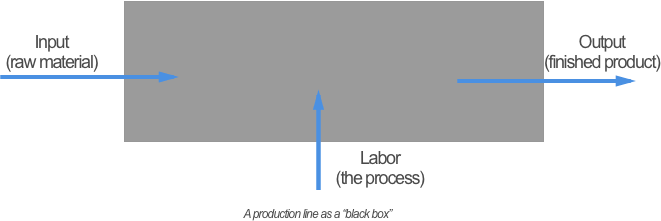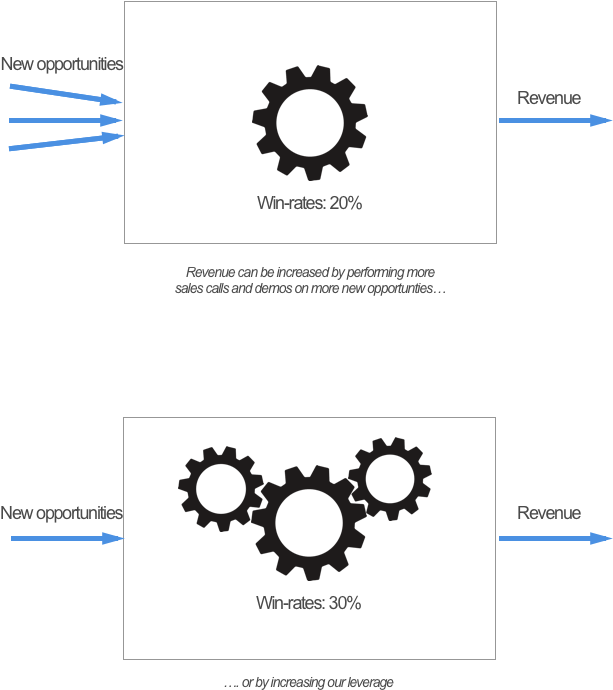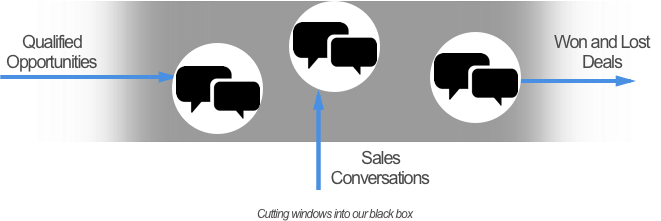Sales strategies
Demo-to-Close Conversion Rates: How Sales Leaders Can Move the Needle

Chris Orlob
Content Author
Published on: May 7, 2017

For Sales Leaders, Increasing your B2B sales team’s conversion rates on opportunities is a tricky task, but can be broken down logically.
Any set of activities that has an output can be viewed as if it were a manufacturing process.
We start with inputs. Those inputs go into a “black box” where they interact with labor, and they come out as outputs. It usually looks something like this:

Raw eggs, untoasted bread, ground coffee beans, and water enter the black box as inputs. Cooks and waiters interact with the raw materials. Finally, on the other side, they come out as a complete breakfast with scrambled eggs, toast, and a steaming cup of coffee.
In the manufacturing world, monitoring systems and measurements are setup to gain clarity and visibility into the black box.
When applied to potential deals in a B2B sales process, the visual looks something like this:

I blurred this image to accentuate the idea that we sales leaders are mostly blind to how our sales team manages their calls and demos.
In other words, we can think of sales calls and demos with prospects as if they are the black box. Input (new qualified opportunities) flow into the box – often at large expense in terms of marketing dollars – and output (won and lost deals) flow out of the box (Usually, it’s going to take multiple conversations to win the deal, but the principles remain the same).
Increasing demo to win rates without leverage: do more, faster
The productivity of any process like this is equal to the output (won revenue) divided by the labor required (sales calls, demos, and other sales activity) to generate the output. Thus, one way to increase our revenue is to do whatever we are currently doing, butmore and faster
In other words, pouring sales opportunities into the black box so we’re having sales conversations. This approach is all about getting more activities per sales rep to flow into the black box. And because the output (revenue yield) of the black box is proportional to the amount of activity that goes on within it, we’ll end up with more revenue.
If you work in sales, you probably refer to this as “working harder.” If you work in marketing, you probably think about this as “filling the funnel.”
Leverage, conversion rates, and the sales process
But there’s a second way to increase the yield from our black box. We can increase the amount of output (revenue) we get per activity (sales call) This approach increases the total revenue we yield even if the number of sales calls we complete remains the same.
As the saying has it, “work smarter, not harder.”
It’s here that I’like to introduce the concept of leverage as it relates to ensuring our pipeline and deals convert into closed revenue.
This approach advocates increasing your opportunity conversion rates rather than only increasing the number of opportunities you pour into your black box. The way this is done is by having better discovery calls, demos, and sales conversations rather than just having moreof them.
Rather than throwing more spaghetti at the wall, leverage is about ensuring more of the spaghetti sticks with each toss.
So, a very important way to increase our revenue is to optimize the work that goes on inside our black box, rather than just increasing the amount of work we perform within the box.

Increasing demo to win rates In B2B sales
We can improve our ability to run any process (and thereby increase our leverage) by cutting some windows into the black box so that we can see some of what goes on within it.
In this case, as sales leaders, we can improve our ability to convert pipeline into revenue by peering into our sales team’s calls and demos, and how they’re being managed.

As sales leaders, if we’re blind to how our sales team is doing their calls and demos, we aren’t in control of making our number. It’s a roll of the dice. There is no leverage. Our only tactic is to pump in more opportunities.
But by cutting some windows, we can answer a few questions:
- Are we putting our best foot forward during our sales meetings?
- Are we doing and saying the right things in order to finish the quarter strong?
- Are we asking good questions, securing next steps, and qualifying effectively?
- Are our reps actually implementing the things we train and coach them on?
- How are we messaging and positioning ourselves in key situations?
The difference between a bad quarter and hitting your number
By looking through these openings, as illustrated above, we can better understand the internal workings and status of our sales process, and assess what our future “revenue output” is likely to be based on how these sales conversations are going.
For example, if we cut a window into our black box, we may learn that our reps are doing really crisp demos and presentations, but tend to skim over discovery and qualification. This makes their forecast no more than a guess if they haven’t done the upfront work of understanding the prospect’s business situation.
This newly identified trend helps us anticipate problems we’re going to run into at the end of the quarter. Namely, deals we expected to close this quarter start to slip out of our grasp and drag on through the next quarter. This is due to our reps making forecasting estimates based on how they felt the demo went rather than the disciplined discovery work they conducted with the potential customer.
Insights such as this flash an early warning signal, allowing us to take corrective action and introduce targeted leverage to our sales efforts: rigorous discovery call training and coaching. Without this window, we would have eventually found ourselves reporting a bad quarter to our boss, rather than making our number and moving onto the next challenge.
Sales conversation insight is the key to increasing conversion rates
Peering into these windows and acting on what we learn is how we can introduce leverage to our sales process.
We can understand what’s working and what’s not, anticipate problems, and make sure our reps are doing and saying the right things on their calls and demos needed to make our number. We can correct underperforming sales behavior, and replicate our top producers’ best practices across the rest of the team.
Let’s say last quarter your competitive deal conversion rates were dismal. To prevent that from happening again this quarter, you’have to get insight into the sales conversations that involved your competition. How were your reps handling competitive positioning and differentiation? How were prospects responding? What advantages did the competition have over us?
Once identified, we can devise a new competitive selling strategy, implement it with our sales team, and ensure it’s being executed by, again, peering into sales conversations.
Moving the needle with conversion rates rather than brute force
I know a SaaS CEO who plans on raising his Series C round later this year.
When it was just him and his first two account executives closing all the deals, they were killing it. They had no problem bringing in six-figure deals, and their pipeline conversion rates were high.
But as his sales team grew, demo-to-close conversion rates began slipping, and the sales cycle became painfully long.
This was a huge problem because his future investors were going to evaluate his company based on those metrics. If he didn’t get his conversion rates up and shorten his sales cycle, it would mean the difference between an $80 million valuation and a $130 million valuation upon closing the round (or worse, it could result in failing to raise the funds entirely).
The situation looked like this:

So he decided to cut some windows into his black box and understand why his sales team’s metrics were slipping. He didn’t need more opportunities; that wouldn’t change his investors’ opinions of his subpar conversion rates and long sales cycle. He needed to understand what his team was doing and saying on their calls and demos to cause this situation so it could be corrected. Note here that training and coaching without this insight would be guesswork. Effort could too easily be misdirected on the wrong area (and in some cases make things worse).
He stayed up until 4 am one night “binge watching” recordings of his sales team’s demos.
He discovered that the messaging that had once worked for him when he was selling was not being used by his sales team. He cringed at how far off his team was from their core messaging and practically had to hold his breath as he listened to some of the calls.

And it’s there where he found his leverage: messaging training for his sales team.
While only time will tell what sort of valuation he gets when he closes his Series C round, his odds are now much better, as he can show investors a higher demo-to-close conversion rate and leaner sales cycle.
Cutting windows into our black box
So far, I’ve outlined what we need: windows into how sales calls and demos are being managed across our sales team. Now let’s talk about how we can cut those windows so we can peer into our black box in a scalable way.
Window #1: Asynchronous windows – call and demo recordings
The word “asynchronous” in this context simply means you’re not tuning into sales conversations as they happen but rather after the fact. In other words,not synchronized.
This is usually done by recording your sales team’s calls and demosto review after the fact.
The benefit here is time efficiency . Sales managers are usually spread too thin to sit in live on their team’s scheduled calls consistently. Call and demo recordings allow sales managers to dip into multiple sales conversations at once by reviewing call recordings in their “down time,” or when it’s convenient for them. They can go from call to call “playlist style” in a single time block rather than sporadically scheduling call shadowing throughout their calendar.
Having call recordings on hand can also be a big help in solving all types of problems. If something goes wrong and your sales numbers start to slip, you’ll have a bank of information you can draw upon to get an understanding of why it’s happening.
If you don’t have this, by the time, you shadow enough sales calls to understand the cause of the problem, it’ll likely be too late and you’ll find yourself reporting a bad month.
Window #2: “Ride alongs” and live shadowing
I admit it: it’s a flawed situation if you can only sit in on 1-2 sales calls per week (assuming you also don’t have call recording access). But it’s even more flawed if you remain completely in the dark as to what’s happening on sales calls by not shadowing (or reviewing call recordings) at all.
Window #3: Conversation intelligence technology
Conversation intelligence platforms – arguably the fastest growing category in B2B sales software – allow sales leaders to scale how much visibility they have into the black box.
These technologies help sales leaders identify what’s working, what’s not, and ensure their reps are doing all the right things by recording, transcribing, and analyzing their calls and demos.
Here’s an example of how conversation intelligence scales your visibility and helps boost the conversion rates on your pipeline opportunities…
I have a friend who happens to be director of sales at a $10M/year SaaS company that you’re probably familiar with. When he first arrived on the job, he got the sense that first calls we lead with their product: reps would almost immediately jump into the demo. So his first task was to create a 1st call sales deck so they could build more context before showing the product.
That deck had three distinct themes for his reps to touch upon throughout the call, with specific language to discuss within each theme. Using the reporting, analytics, and AI that conversation intelligence platforms can provide, he was able to understand which themes were or were not being discussed across all of his team’s first calls.
Lo and behold, after the first week of implementing this deck, very few reps were discussing all three themes in detail. Had he not cut this window into his black box, he would have gone on in blissful ignorance, thinking his 1st call deck was being used as expected.
This provided him a high leverage, course-correcting action: first call deck certifications, and personalized coaching per rep. To get certified, each rep had to send him three call recordings where they skillfully touched on all three themes during the first call.
Being able to track and see if his reps were actually adopting the change in their sales process paid dividends. Adoption of the first call deck skyrocketed. And as they tied this behavior of following the three themes to CRM outcomes via the conversation analytics, they discovered that the new process was leading to higher rates of advancing deals to the next stage.
It helped him understand what was working and what wasn’t.
Identifying how to win competitive deals
Another friend of mine is the VP of Sales for a marketing automation software company.
They found themselves losing a large sum of deals to their competition during the previous quarter. So, he used his conversation intelligence platform to search for and analyze all of the calls where his competitors were discussed during that quarter. He listened to all the critical moments within these calls as if they were a playlist so he could quickly diagnose why they were losing to the competition.
The result: A new competitive selling strategy was implemented quarter to correct the situation.
That could never have happened without carving that specific window into his black box: insight into competitive sales conversations
Conclusion: Conversion rates will stand as still as you do
Like I mentioned, this isn’t the only way to increase the revenue coming out of your pipeline. But increasing your 1st call-to-close conversion rate is the highest leverage, and cheapest option you have.
I urge you to do whatever you can with what you’ve got. Listen to call recordings if you have them. Sit in on a few sales calls. Even if it’s a small amount, cut a few windows into your black box. Get your ears on as many sales conversations as you can. It’s the first step in helping your team have well-executed sales calls and crisp demos that you can be proud of.
If you remain blind, you’ll swim in circles trying to increase your sales team’s conversion rates as they stubbornly refuse to budge.
But if you do get some visibility, your prospects will come away from a call with your reps thinking “Damn, these guys are good,” and you’ll see the needle start to move.
If you’re interested in peering into your black box in a more scalable, time-efficient way, request a demo or free trial of the Gong conversation intelligence platform
Further Reading
Increase sales win rates – How to Increase Sales Win-Rates By 32% Using “Risk-Reversal Language”
How Cirrus Insight and Greenhouse Use Conversation Intelligence to Help Reps Sell Better
5 Call Coaching Practices That Will Help Your Account Executives Nail Their Demos
9 Data-Driven Call Coaching Habits of Effective Sales Leaders
5 Reasons Call Recordings Beat Live Shadowing for Sales Coaching


Content Author
Chris Orlob is the Co-Founder and CEO of Pclub.io, a leading sales training platform designed to help sales professionals accelerate their revenue growth. He is best known for his pivotal role at Gong, where he helped scale the company from $200,000 to $200 million in ARR, contributing to a $7.2 billion valuation. During his tenure at Gong, Chris led the creation of Gong Labs and excelled in various go-to-market roles. Today, through Pclub.io, he leverages his deep expertise in sales and revenue operations to coach over 11,000 SaaS sellers.
Discover more from Gong
Check out the latest product information, executive insights, and selling tips and tricks, all on the Gong blog.



